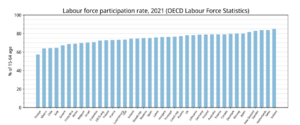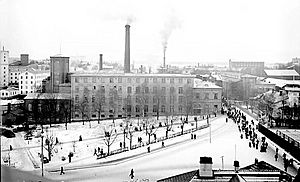Workforce facts for kids
The workforce or labour force is a term for all the people who are either working or actively looking for a job. It can describe the workers in a single company or a whole industry. It can also refer to all the people working in a city, state, or even an entire country. When we talk about a country's workforce, it includes both those who have jobs and those who are unemployed but want to work.
Contents
Working Formally and Informally
Working formally means having a structured job that pays you in an official way. This kind of work is usually recognized by the government and helps a country's economy grow.
Informal work, on the other hand, is less structured and often not officially recognized. It might be paid or unpaid, and it doesn't always follow official rules. Formal jobs are generally more stable. They often offer better pay and benefits, like health insurance or retirement plans, for both men and women.
What is Informal Work?
Informal workers play a huge role in many economies, especially in developing countries. This type of work is growing worldwide. For example, in the year 2000, informal jobs made up a large part of new jobs in places like Latin America (83%) and Africa (93%). After an economic crisis, like the one in Asia in 1997, many people often move from formal jobs to informal ones.
Informal Work and Gender
Gender often plays a part in informal work. Women are more likely to have informal jobs than men. For women, informal work is a bigger source of employment overall. Many women in the informal sector work as home-based workers or street vendors. For instance, in the 1990s, a large percentage of women in countries like Benin (81%) and Guatemala (55%) were street vendors.
Globally, about 60% of women workers in developing countries have informal jobs. In some parts of the world, like Sub-Saharan Africa, 92% of women workers are in informal employment, compared to 86% of men.
Informal work can also be divided into farm work (agricultural) and non-farm work. Most farm work is informal, meaning it's not officially registered. Non-farm work can also be informal. For example, informal work makes up 72% of non-farm jobs in Sub-Saharan Africa.
Farming and informal economic activities are very important for women to earn a living. Women make up about 70% of informal traders who cross borders to sell goods. They also own many small and medium-sized businesses. These smaller businesses can be more easily affected by economic changes. Women-owned businesses sometimes find it harder to get loans or money compared to larger companies.
Paid and Unpaid Work
Work can be paid or unpaid. Some informal work is unpaid, or paid "under the table" (unofficially). Unpaid work can include taking care of a family at home, like childcare. It can also be daily work that doesn't earn money, like working in fields for your family's food.
Unpaid workers don't earn money, but their work is still very valuable. It's hard to put a money value on it. Men and women often do different types of work, whether it's paid or unpaid. Women often work in the service sector (like helping people), while men often work in the industrial sector (like making things).
Unpaid Work and Gender
Women usually spend fewer hours in jobs that earn money than men do. Often, the unpaid work they do is housework. Around the world, women and girls are responsible for a lot of household chores.
For example, in Madagascar, women spend about 20 hours a week on housework, while men spend only two hours. In Mexico, women spend 33 hours and men spend 5 hours. In Spain, women spend 26 hours on housework and men spend 4 hours.
In developing countries, women and girls also spend a lot of time getting water each week. For instance, in Malawi, women spend 6.3 hours a week getting water, while men spend only 43 minutes. Girls in Malawi spend 3.3 hours a week getting water, and boys spend 1.1 hours. Even when both men and women do household work, the types of tasks often differ by gender.
Sick Leave and Gender
In the United Kingdom in 2014, two out of three workers who were on long-term sick leave were women. This was true even though women made up only half of the total workforce, and this number doesn't even include maternity leave.
See also
 In Spanish: Mano de obra para niños
In Spanish: Mano de obra para niños
- Collective bargaining
- Contingent workforce
- Critique of work
- Designation of workers by collar color
- Division of labour
- Employment-to-population ratio
- Female labor force in the Muslim world
- Feminisation of poverty
- Human capital
- Labour economics
- List of countries by labor force
- List of countries by sector composition of the labor force
- Proletariat
- Unemployment
- Women in the workforce
- Working class
Sources
![]() This article incorporates text from a free content work. Licensed under CC BY-SA 3.0 License statement/permission on Wikimedia Commons. Text taken from Seizing the opportunities of the African Continental Free Trade Area for the economic empowerment of women in agriculture, FAO, FAO.
This article incorporates text from a free content work. Licensed under CC BY-SA 3.0 License statement/permission on Wikimedia Commons. Text taken from Seizing the opportunities of the African Continental Free Trade Area for the economic empowerment of women in agriculture, FAO, FAO.



